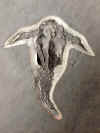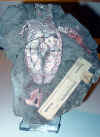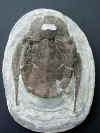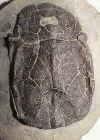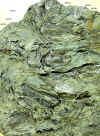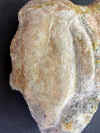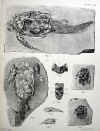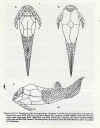PLACODERMI Antiarchs, Ptyctodonts, Rhenanids and Petalichthyids
Antiarchs
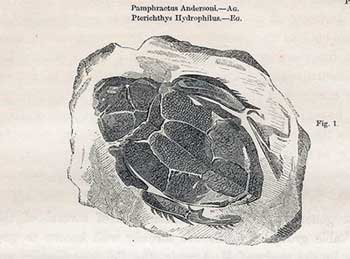
Bothriolepis sp. from 'Dura Den - A monograph of the Yellow sandstone' 1859 J Anderson
Characterised by having the pectoral fins modified into jointed appendages
covered with dermal plates and much larger thoracic armour (comprised of 2
Median Dorsal plates) compared to the head armour (which features a single
opening for the eyes, olfactory and pineal organs). The Superognathal of the
antiarchs is replaced by a suborbital cutting plate. The body and tail can be
covered with large scales as in Pterichtyodes or almost naked as in Bothriolepis.
The diversity of this group is not great but they were probably the most common
fishes of the Late Devonian although mostly limited to freshwater or deltaic
environments (although Bothriolepis is
also present in the Gogo fauna of the reef complexes in
Antiarchs in my collection (click on thumbnails to see larger images)
Pterichthyodes milleri Mid Devonian
Confined to the Achanarras Horizon of the MORS this fish reached acout 18cm in length.

 Orkney,
Scotland (note
superb tail and lateral presentation)
Orkney,
Scotland (note
superb tail and lateral presentation)
Microbranchius dicki Mid Devonian Eday Beds, Orkney Islands
This tiny antiarch reached only 3 cm in length and was restricted to the John O' Groats sandstones and equivalents
Bothriolepis canadenesis Upper Devonian, Escuminac Formation, Miguasha, Quebec, Canada
Bothriolepis canadenesis mass mortality plate with Scaumenacia and plant material
xxxxxxxxxxxxxxxxxxxxxxxxxxxxxxxxxxxxxxxx
Pterichthyodes images from Woodward 1899 and 'The fishes of the ORS of Britain' Traquair, 1904
Ptyctodont Placoderms
In many respects the Ptyctodonts (‘beak tooth’) resemble the extant chimaerids with crushing (trabecular) plates in the jaws. They are the only Placoderms that show sexual dimorphism with the male having claspers in both Ctenurella and Rhamphodopsis. They had reduced head plates, reduced thoracic shields and long bodies.
![]() Ctenurella gladbachensis
U
Devonian,
Bergisch Gladbach,
Germany
Ctenurella gladbachensis
U
Devonian,
Bergisch Gladbach,
Germany
 Rhamphodopsis threiplandi, Edderton, Scotland
Rhamphodopsis threiplandi, Edderton, Scotland
Rhenanid Placoderms
These placoderms are very similar to extant skates and rays, being characterised by considerably enlarged pectoral fins (even the braincase, labyrinth and other internal features are suggestive of batomorphs) however, they are clearly placoderms as shown by the pattern of dermal plates.
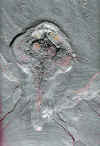 Gemuendina Early
Devonian Bundenbach, Germany
Gemuendina Early
Devonian Bundenbach, Germany

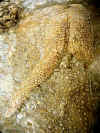
 Jagorina. Rhenanid. Devonian of Morocco
Jagorina. Rhenanid. Devonian of Morocco
Petalichthyid Placoderms
Characterised by having dorsal orbits, these placoderms have widely splayed pectoral fins and long spinal plates. Lunaspis from Early Devonian Bundenbach slate of Germany is the best known example.
Acanthothoraci, Stensioellida and Pseudopetalichthyida Placoderms.
